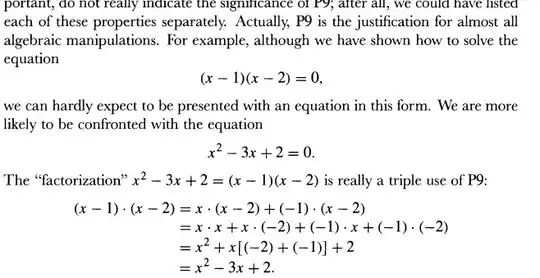I can see how a reader might easily be confused by the passage that you quoted. It seems that Spivak's goal here is to emphasize the fundamental role played by $\rm P9$ (the Distributive Law) by highlighting the key that it plays in even the simplest of arithmetical (ring-theoretic) calculations, such as factoring a quadratic polynomial, law of signs, etc. Because the distributive law is the only law that connects the additive structure to the multiplicative structure in a ring, it must be used in any proof of a theorem that is not purely additive, or purely multiplicative.
Without the distributive law a ring degenerates to a set with two completely unrelated additive and multiplicative structures. So, in a sense, the distributive law is a keystone of the ring structure.
The proof that he gives of the "factorization" $x^2-3x+2 = (x-1)(x-2)$ is not meant to be read as the derivation (discovery) of the factorization but, rather, simply as a proof that this equation is true. The point is simply to illustrate the key role that $\rm P9$ plays in proving this equality.
Normally transforming the lhs to rhs, i.e $\,x^2-3x+2$ to $(x-1)(x-2),$ is called factorization, and the reverse direction is called expansion. Each necessarily involves multiple applications of the distributive law $\rm P9$ (in various directions). Probably the reason Spivak put scare quotes around the word "factorization" is because the equation could be read either way, as a factorization or an expansion. What makes matters more confusing is that his proof of the "factorization" equality actually goes from rhs to lhs, so it would normally by called an expansion of $\,(\color{#c00}{x-1})(x-2)\,$ by distributing the factor $\,x-2\,$ into the summands $\,\color{#c00}x\,$ and $\,\color{#c00}{-1},\,$ yielding
$$\begin{align} &(\color{#c00}{x}\ +\ (\color{#c00}{-1}))\, (x-2) \\[.4em] =\ & \color{#c00}x(\color{#0a0}{x-2}) + (\color{#c00}{-1})(x-2)\end{align}$$
then distribute $\,\color{#c00}x\,$ into the summands $\,\color{#0a0}x\,$ and $\,\color{#0a0}{-2},\,$ and similarly distribute $\color{#c00}{-1}$ yielding
$$x(\color{#0a0}{x}) + x(\color{#0a0}{-2}) + (-1)x + (-1)(-2)$$
Thus this complete expansion applied the distributive law four times in total.
In any case, don't let the unoriented terminology disorient you. You can safely ignore this, since Spivak's point is not to give a definition of factorization or expansion but, rather, to show prototypical applications of $\rm P9$.
